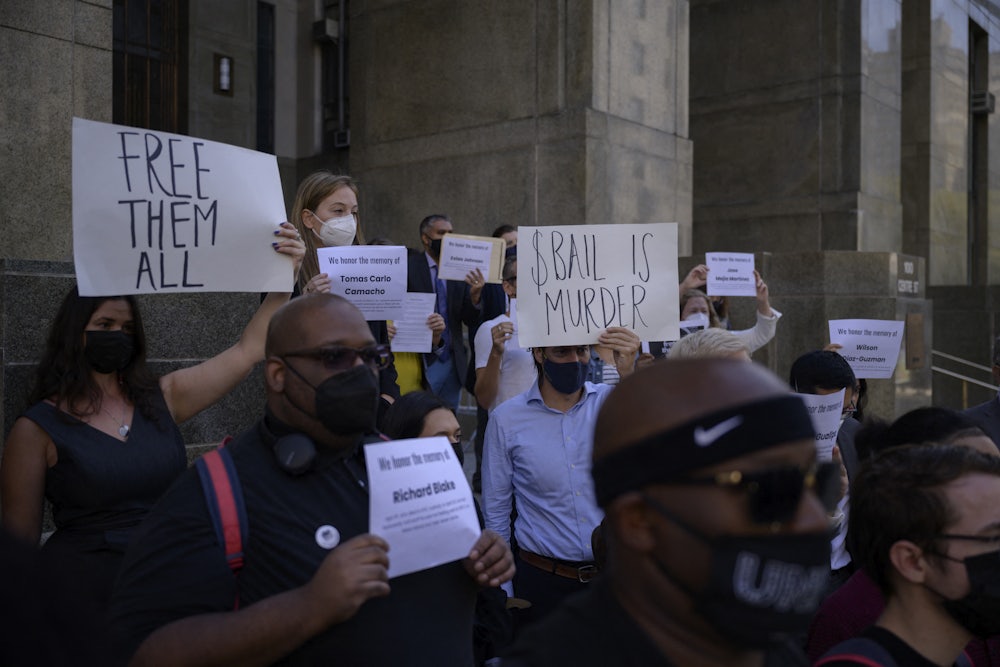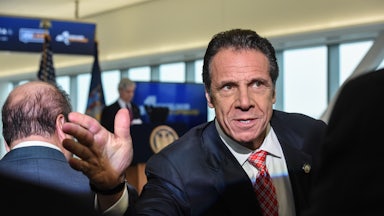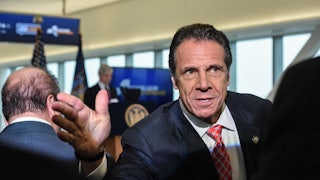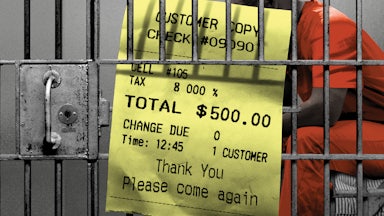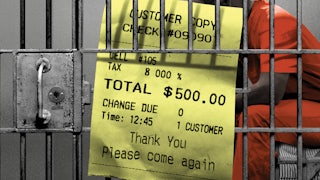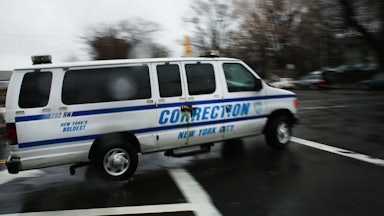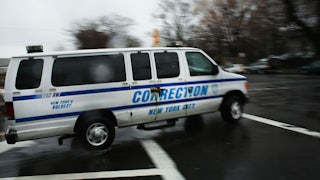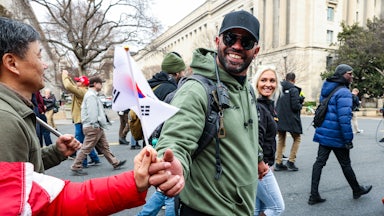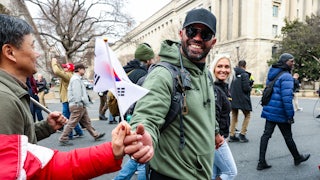The Manhattan criminal courthouse where arraignments take place is a massive structure, a 17-story Art Deco affair with high ceilings and dark wood paneling. These days, the formality of the rooms is somewhat interrupted by the plexiglass panels that encase every podium and desk. On a recent Wednesday night, there was an unusual number of spectators—eight or nine people filling the benches. Abigail Callaghan, a 29-year-old volunteer with Court Watch NYC, said that usually on a weeknight there might only be one or two people, family and friends there to see their loved ones arraigned. But as it turns out, more than one member of the press was in attendance that evening, because the man who burned down the Christmas tree in front of Fox News was scheduled to be seen by a judge.
A less headline-grabbing story on offer that night was the fact that, according to the local bail fund, someone is jailed in New York City about every 30 minutes, often because they can’t afford bail, even following a slate of recent reforms. Court Watch, which was founded in 2018 in New York City, takes the position that training and deploying designated observers can increase prosecutor accountability and provide useful data on how reform is being enacted in real time. The New York program takes after a 2017 effort organized in Chicago to hold judges accountable; similar projects have launched in California and Massachusetts over the last few years. The New York court watchers carry forms that mimic the sterile bureaucracy of the court system itself, transcribing docket numbers and checking off demographic indicators in an attempt to glean as much specific information as possible from rapid-fire procedures lasting just a few minutes. During a three-hour shift, Callaghan says she’s seen as many as 30 arraignments.
Volunteers, of whom Court Watch NYC says it has trained close to 400 this year, familiarize themselves with particularly difficult court officers and judges. For a lot of New Yorkers, says Callaghan, these courts are “unseen, elsewhere places,” a technically public forum made invisible by a lack of procedural fluency and public attention. And sometimes she says just the presence of an observer can have a tangible effect: “I had a public defender come up to me once and say, ‘Thank you, judges will set lower bail if you’re in the room.’”
In 2019, New York passed one of the most progressive bail-reform packages in the country, only to see many of those changes rolled back a year later after the NYPD and conservative tabloids took the stance that lower bails translated directly into higher incidences of violent crime. Currently, New York law allows judges to set bail on most violent felonies if there is a risk a suspect will flee; as an investigation by New York State Focus found this year, however, individual judges will often cite flight risk and impose unaffordable bails for reasons other than an honest effort to get people back in court. “Look, if a judge wants to lock somebody up, they’re going to lock somebody up,” a former prosecutor told the outlet, and data shows that over time, reforms have a way of succumbing to entropy. “Court data suggests the judiciary has become increasingly unable, or unwilling, to follow the law,” NYS Focus concluded. The consequences can be horrific: In October, a man who contracted the coronavirus at Rikers after being unable to post $100,000 bail became the thirteenth person to die in a New York City prison this year.
In the courtroom, during the “dinner shift,” a period between 6 p.m. and 9 p.m. when criminal arraignments are held, there is the constant sound of shuffling. The building is both courtroom and office—between and during arraignments, public defenders take phone calls; clerks handle paperwork; NYPD officers, one wearing a bulletproof vest despite the metal detector at the building entrance, move in and out of the room with coffee cups. The court translator bumps fists with a knot of officers, jostling his buddies, while a family discreetly rocks an infant in a pink stroller toward the back of the room. When the doors behind the judge’s podium swing open to admit an alleged criminal to the room, the jovial nature of the court is interrupted by the briefly visible bars on the other side of the court’s wainscoted facade.
A middle-aged man is charged with assault and harassment; the judge issues a temporary order of protection and provides a window during which the man can return home and collect his things. A guy wearing all white is charged with criminal intent; the judge wants to issue a $10,000 cash bail. Instead, he is placed on supervised release after his public defender argues he’s a native New Yorker and has lived in the same place for the last four years, making it unlikely he would flee. A lanky kid wearing a sweatsuit is uncuffed in front of the judge; he’s been charged with menacing in the second degree, but his public defender says his client was the one to call 911. He, too, is placed on supervised release and once he takes his seat in the back of the courtroom, a legal aid representative hands him a MetroCard so he can get home. Another man listens to the long list of disclosures translated by a public employee in a purple suit jacket—that this will appear on his criminal record, that if he is undocumented he may be ejected from the country—before enthusiastically pleading guilty under the condition that some of his charges are dismissed. He is sentenced to time served. “There’s often very little context to what happened,” Callaghan says. She approaches two supervised release agents to see if she can get the name of the judge and fills out the check boxes on her form.
According to Callaghan, who has been court watching off and on since 2017, there’s been a spike in supervised release conditions in these courtrooms since bail reform imposed the idea that judges should take advantage of the “least restrictive means” to ensure someone returns for their court date. But on Monday, she says, she watched a judge try to impose a $75,000 bail on an unemployed person. The public defender argued that wasn’t reasonable given that the person in question didn’t have a job or a home. The judge suggested $30,000 instead. “As if it makes a difference,” Callaghan said.
She got into this work after going to arraignments for friends and an ex-partner in Seattle, navigating the system for the first time. “People are there to see loved ones, and there’s no one telling them what’s going on. The court officer isn’t the most inviting, so there are a lot of confused people.” At the end of her shift, she’ll look for the court officer and try to get the docket numbers she needs—technically, they should be listed on the board in front of the courtroom, but in reality that’s almost never the case. Back at home, she’ll enter everything she collected into an online form, volunteer-generated data points to be collated at some later date.
In 2020, Court Watch NYC released a report on the first 100 days of bail reform in New York City. After 360 hours spent watching 937 people be arraigned in criminal court, the organization said those reforms were useful “Band-Aids,” but that prosecutors, police, and judges were finding new ways to “monitor and control” people. Without cash bail options, they were still using the most extreme punishments available, most often to charge or jail New Yorkers who were Black.
